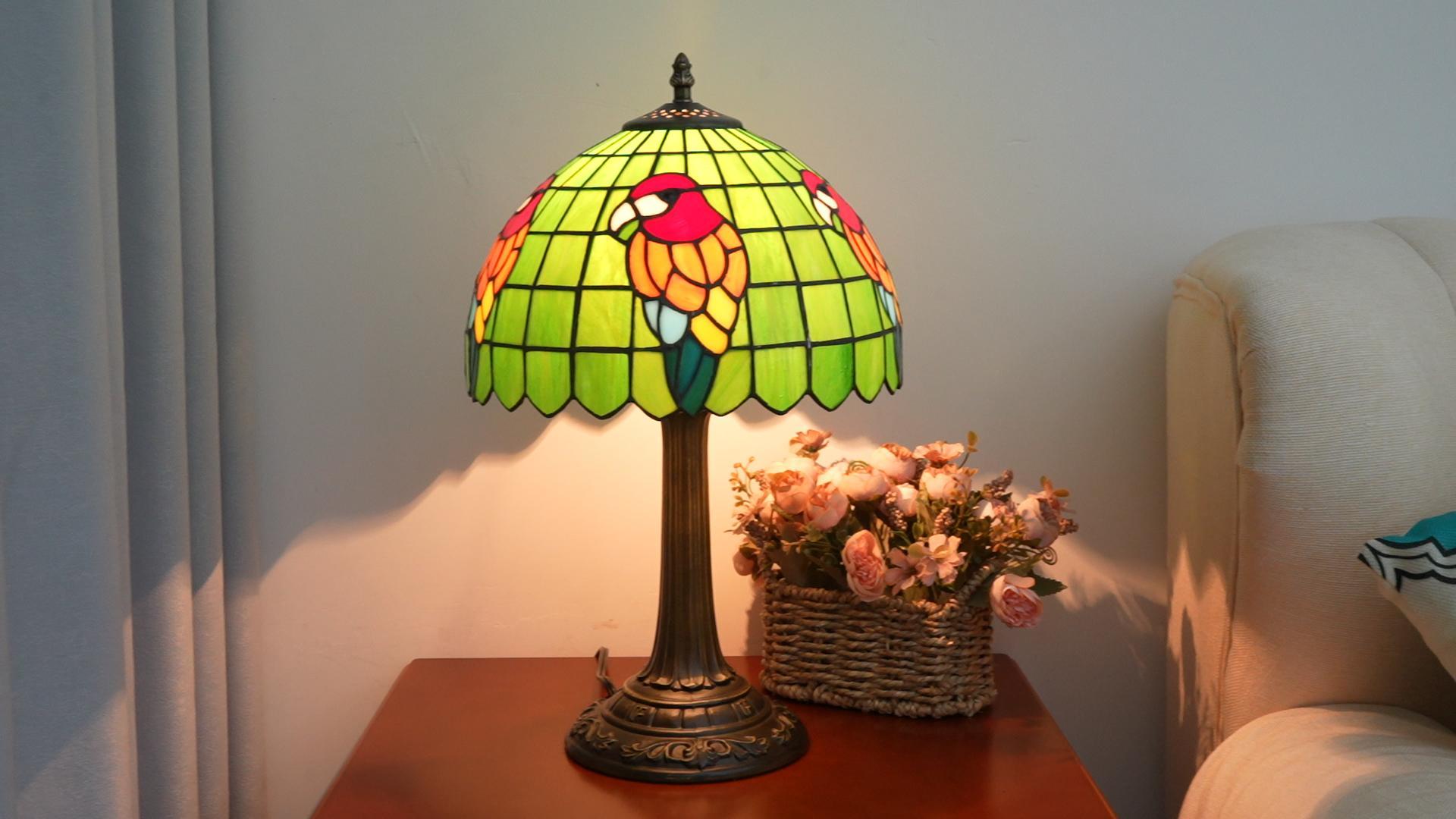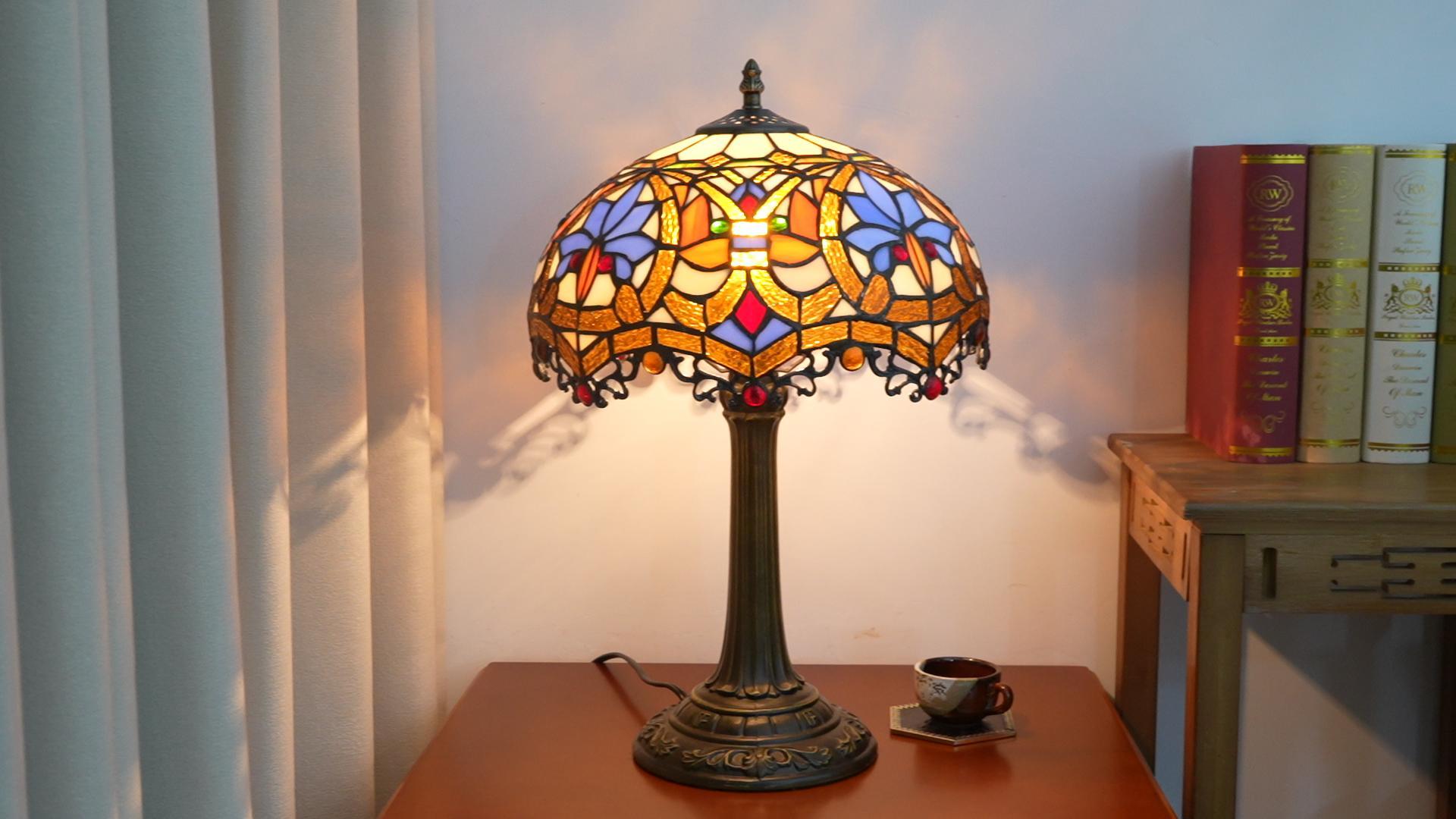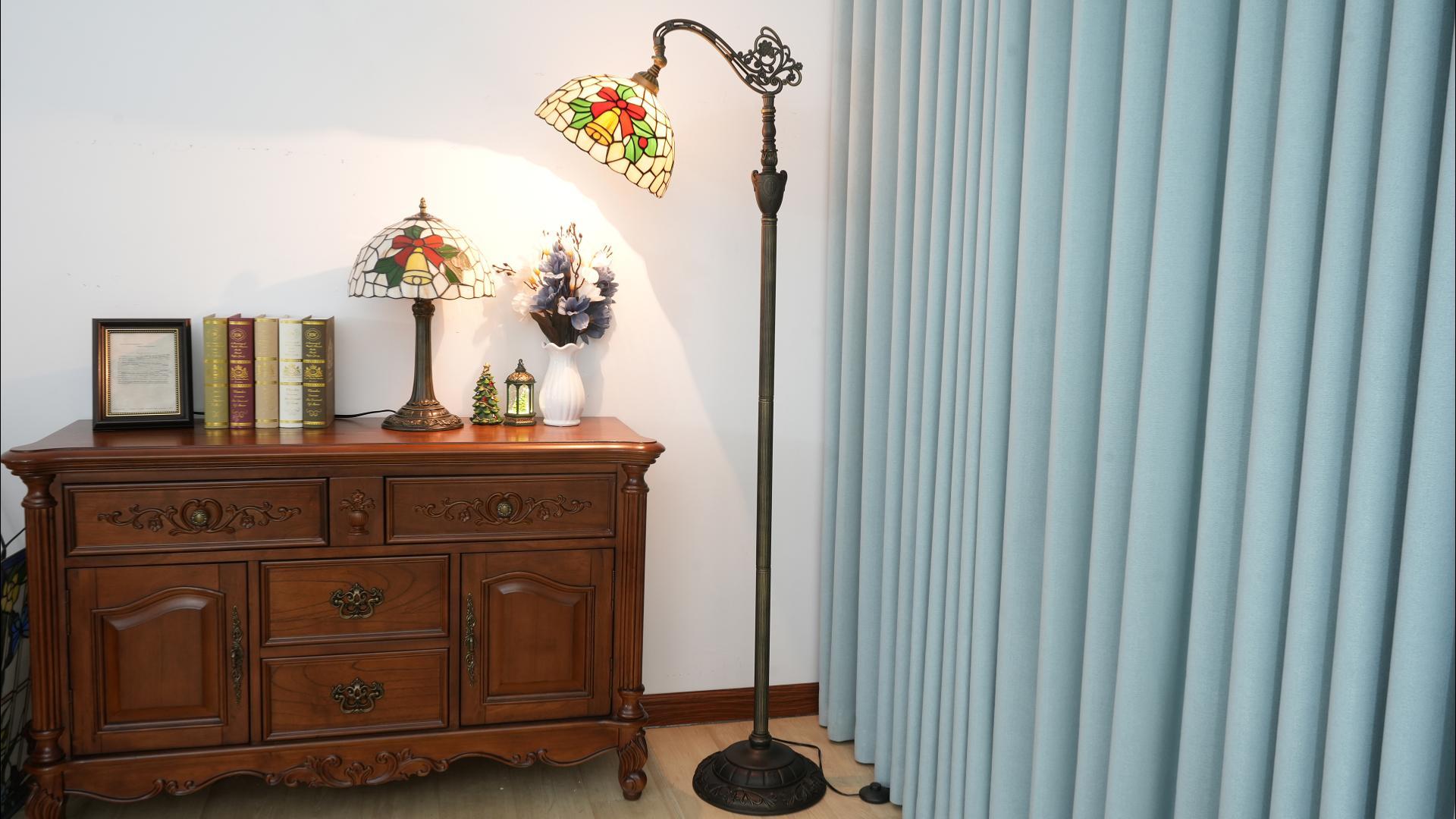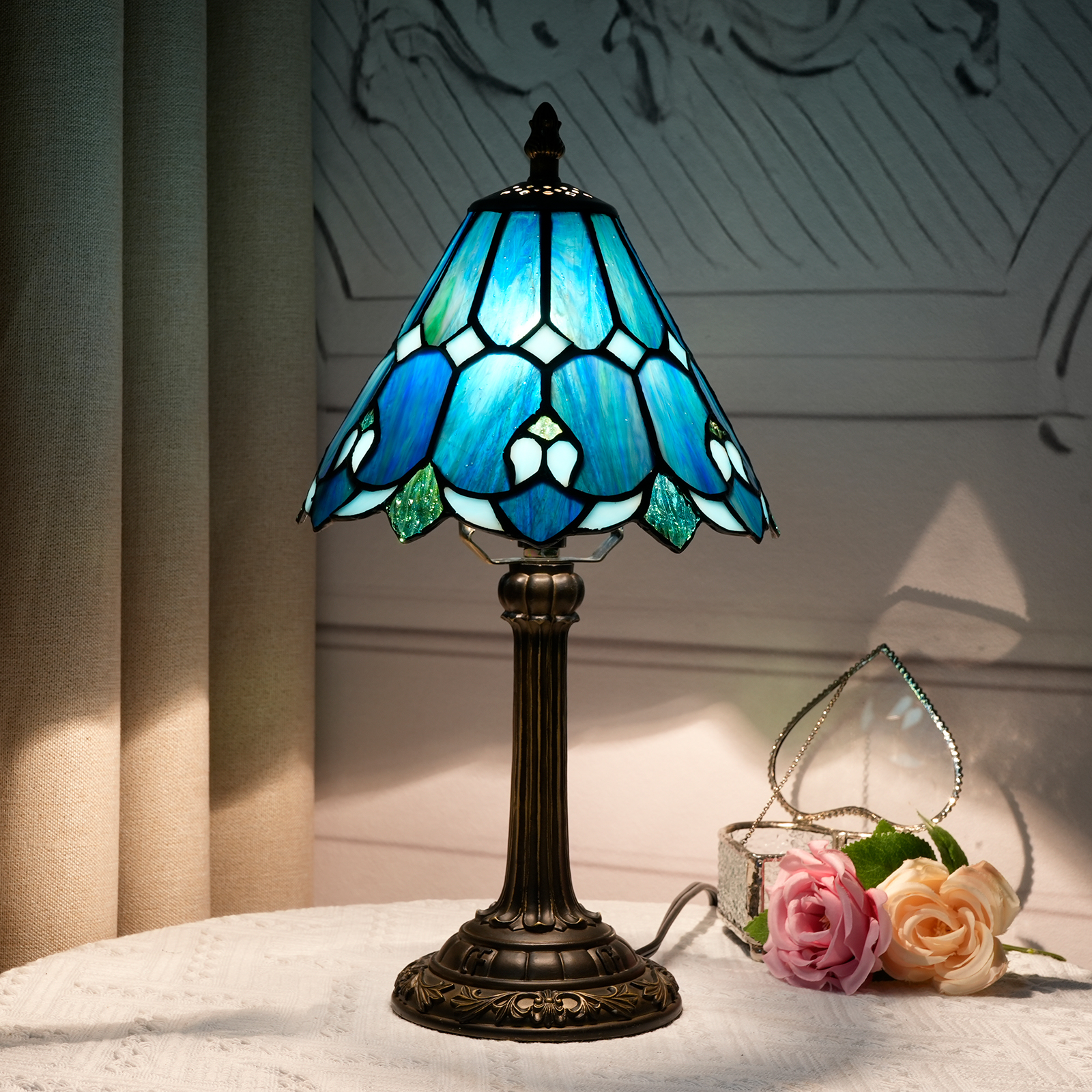12-inch Tiffany style blue-green Dragonfly table lamp: The beauty of the integration of art and life
I. Tiffany Style: The Inheritance of a Century of Art
The Tiffany style originated in the United States at the end of the 19th century and was founded and reached its peak by Louis Comfort Tiffany. In an era when the Industrial Revolution swept through and machine production began to dominate daily necessities, Tiffany persisted in handcrafted art creation, taking colored glass as the core carrier, breaking the monotonous and dull visual presentation of traditional glass products, and bringing the techniques of glass cutting, splicing, and firing to the extreme, endowing glass with a brilliant luster like a gemstone and artistic vitality.
Its style is distinctive. On the one hand, it is good at using natural elements, such as flowers, insects, birds and beasts, which are all sources of inspiration. Through the colors and forms of glass, it restores the vitality and beauty of nature. On the other hand, emphasizing the warmth of handcrafting, every piece of Tiffany style work, from the Angle of glass cutting, the curvature of metal edge wrapping, to the construction of the overall shape, is filled with the craftsmanship and hard work of the artisans, rejecting the uniformity of industrial replication. After a century, the Tiffany style has not only not faded with time, but has instead become a synonym for retro art and handcrafted aesthetics, continuously influencing fields such as home decoration and art collection. This 12-inch blue-green dragonfly desk lamp is a vivid interpretation of the Tiffany style in contemporary times.
Ii. Analysis of Basic Product Parameters and Materials
(1) Dimensions and Specifications
This desk lamp has a lampshade diameter of 12 inches (about 30CM), an overall height of 48CM (about 19 inches), a base diameter of 16.6CM (about 6.5 inches), and a wire length of 145CM. This size design not only ensures that the lampshade can emit soft light sufficient to cover a small space and create a warm atmosphere, but also gives the overall shape a just right visual center of gravity when placed on the table. It will neither appear bulky due to being too large nor lose its presence due to being too small.
(2) Colored glass lampshade: An artistic canvas of light and color
The lampshade is made of colored glass, which is the soul of the Tiffany style. Each piece of glass has been carefully selected and cut. The color system mainly featuring blue-green tones is inspired by the blending of lake water and leaves in nature, presenting a fresh and layered look. During the firing process of glass, different temperatures and techniques cause the colors to present a gradient and transition of varying shades, brightness or darkness. When light passes through, it seems to bring the natural magic of light and shadow into the interior.
The manual splicing technique is even more crucial. Craftsmen need to precisely control the position and Angle of each piece of glass, and fix them with metal edges (usually copper). The luster of the metal and the color of the glass complement each other, while ensuring the stability of the structure. This kind of splicing is not a simple physical combination. Instead, through the matching of glass shapes and colors, it Outlines the texture of the dragonfly's wings, the form of its body, and the color blending similar to the natural environment in the background, making the dragonfly pattern come alive as if it were about to flap its wings and fly out of the lampshade.
(3) Resin base: A balance between retro and practicality
The base is made of resin material and processed by a special technique, presenting a retro color and texture that imitates metal. Compared with metal, resin is easier to control in terms of weight, reducing the risk of the entire desk lamp toppling over. At the same time, it has good corrosion resistance and wear resistance, and is less likely to rust or deform over long-term use.
The surface of the base is carved with exquisite patterns. These patterns are not randomly designed but continue the Tiffany style's preference for natural and retro elements. They might be a fusion of scroll patterns and geometric patterns, echoing the natural theme of the lampshade and enhancing the overall artistic atmosphere from the details. The height and curvature design of the base not only ensure a reasonable distance between the lampshade and the table surface (facilitating light diffusion), but also create a visual rhythm of "contraction - expansion - contraction" : the base is steady and stable, the transition of the lamp post is natural, and the lampshade is expansive and dynamic.
Iii. Handcrafted: Endowing the product with a unique soul
(1) Manual process: The temperature from design to molding
The design draft is born: The designer needs to conduct in-depth research on historical works in the Tiffany style, combine modern aesthetics with practical needs, and draw the design blueprint of the desk lamp. Taking dragonflies as the theme, it is necessary to precisely grasp the morphological proportion and color distribution of dragonflies. At the same time, plan the shape and quantity of glass cutting, as well as the style of the base pattern, so that the design not only inherits the classics but also conforms to the contemporary home scene.
Glass cutting and selection: Craftsmen cut large pieces of colored glass based on the design draft. This step tests your skills. You need to use special tools to cut the glass into small pieces that meet the pattern requirements. The error must be controlled within a very small range; otherwise, it will affect the splicing effect. After cutting, each piece should be selected one by one to ensure that the color and transparency are consistent with the design expectations. For example, for blue-green glass, the color tone differences of different batches should be distinguished to ensure the harmony of the lampshade color.
Splicing and edge wrapping: The cut glass is spliced in sequence, and the edges of the glass are wrapped with metal strips (mostly copper strips), and then fixed through welding and other processes. During this process, the craftsman needs to adjust the Angle and spacing of the glass to ensure that the light passing through can produce the preset refraction and reflection effects. At the same time, the flatness and aesthetics of the metal edge wrapping must be guaranteed. Every joint must be handled meticulously to present a smooth pattern outline.
Base production and assembly: The resin base is made through processes such as mold casting, post-grinding, coloring, and engraving. Then, the lampshade and the base are assembled through suitable connecting parts, and the balance and stability are adjusted to ensure that the desk lamp can be used normally and is aesthetically pleasing without any flaws.
(2) Handmade Value: An irreplicable artistic warmth
In the current era when machine production is prevalent, handcrafting implies uniqueness and scarcity. The subtle differences in the glass cutting angles and the joints of each desk lamp, as well as the hand-carved marks on the base patterns, all make them "unique" existences. This difference is not a defect but the charm of handcrafted art - it carries the craftsman's thoughts, emotions and experiences during operation. When users place the desk lamp at home, what they touch is not only the texture of the material, but also the warmth of handcrafted creation, an emotional connection that industrial products cannot offer.
Meanwhile, handcrafting ensures the fineness of the craftsmanship and the artistic standard. Although machine production can achieve standardization, in the face of the Tiffany style, which emphasizes natural forms, color integration and detailed polishing, it is difficult to replicate the precise control of glass light and shadow by hand, the creation of vivid patterns, and the creation of an overall artistic atmosphere. It can be said that handcrafting is the core support for this desk lamp to become an "art piece" rather than an ordinary "lighting tool".
Iv. Blue-green Dragonfly Theme: Artistic Transformation of Natural Inspiration
(1) The symbolic and aesthetic significance of the dragonfly element
The dragonfly has always been a symbol of agility, freedom and freshness in the fields of culture and aesthetics. It shuttles among nature. The transparent texture of its wings and the light posture of its flight convey its yearning for the vitality of nature. In Tiffany style works, natural elements are common themes. Dragonflies, with their unique forms and visual beauty, have become one of the classic topics.
From an aesthetic perspective, the body lines and wing textures of dragonflies provide rich modeling materials for design. In this desk lamp, the dragonfly pattern breaks free from the constraints of a flat surface. Through the three-dimensional splicing of colored glass, the transparency of the wings and the color gradation of the body are presented, as if a real dragonfly is frozen on the lampshade. When the light penetrates, the texture and color changes of the wings add a dynamic visual effect, endowing the static desk lamp with the lively rhythm of natural life.
(2) Creating an atmosphere with blue-green tones
The blue-green tone is the color of the natural blend of lake water and vegetation, inherently possessing a fresh and serene attribute. When applied to the lampshade of a desk lamp, on the one hand, it injects a natural atmosphere into the indoor space, alleviates the restlessness and noise of modern life, and is especially suitable for placement in areas such as bedrooms and studies that need to create a relaxing atmosphere. On the other hand, the blue-green color palette is rich in layers. The combination of different shades of blue and green glass, along with the penetration and reflection of light, can create a light and shadow atmosphere in the space that is like a forest in the early morning or a lakeside in the afternoon, allowing users to experience the beauty of nature indoors.
This color tone choice also aligns with Tiffany's understanding of color - not pursuing the strong impact of high saturation, but rather conveying a reserved and lasting aesthetic experience through the integration and transition of natural colors, making the desk lamp not only a lighting tool, but also a "palette" and "creator" of the spatial atmosphere.
V. Home Adaptation Scenarios and Atmosphere Creation
(1) Living Room: The finishing touch of spatial art
In the living room setting, this desk lamp can be placed beside the sofa table or beside the display cabinet. If the living room is in a retro American style, paired with leather sofas and solid wood furniture, the Tiffany style of the table lamp can blend perfectly with the overall retro atmosphere and become a symbol of artistic taste in the space. If it is a modern and simple style living room, the blue-green tones of the table lamp and the sense of handcrafted art can break the monotony of simplicity, creating a visual focus with retro art elements and colliding with a unique mix-and-match aesthetic.
When the evening lights come on, the soft light emitted by the desk lamp creates a contrast with the brightness of the main light in the living room, illuminating the reading area in the corner of the sofa or adding a layer of light and shadow to the ornaments on the display cabinet. This allows the living room to strike a balance between practical functionality and artistic atmosphere, becoming a natural aesthetic highlight that attracts attention when family members communicate or guests visit.
(2) Bedroom: The creator of warmth and romance
The bedroom is a private resting space. This desk lamp is placed by the bedside, and its advantages are fully displayed. Before going to bed, the warm yellow light passes through the blue-green glass, becoming soft and rich in color gradation. It not only meets the lighting needs for reading (the design of the diameter and height of the lampshade ensures that the light covers the headboard area), but also does not irritate the eyes like strong light.
From the perspective of atmosphere creation, the blue-green tones bring a sense of tranquility, and the dragonfly pattern conveys the vitality of nature. Combined with the soft texture of the bedding and the gentle pleats of the curtains, it can create a warm, romantic and slightly retro artistic sleeping environment. When getting up at night, soft light can also prevent strong light from dazzling the eyes, keeping the bedroom always comfortable to live in, and becoming a small joy that improves sleep quality and life happiness.
(3) Study: A place where humanity and art blend
In a study, a desk lamp is an important auxiliary lighting and atmosphere element. Placed in a corner of the desk, its sense of handcrafted art and the cultural background of Tiffany style can echo humanistic elements such as books and stationery ornaments, creating a stylish reading and creation environment. The blue-green tones relieve visual fatigue. The soft light is suitable for local illumination during long reading, allowing the eyes to have a comfortable experience between the text and the light and shadow.
At the same time, when friends visit and communicate in the study, the artistic shape and unique light and shadow of the desk lamp can become a natural starting point for the topic, showcasing the owner's aesthetic taste and pursuit of life details, transforming the study from a simple space for work and study into a warm venue for humanistic and artistic exchanges.
Vi. Product Comparison: The differentiated advantages are highlighted
(1) Comparison with ordinary industrial table lamps
Ordinary industrial table lamps are oriented towards standardization and low cost. They mostly use simple combinations of plastic and metal. In design, they pursue practicality first and lack artistic sense. This Tiffany style desk lamp is a world apart in terms of material and craftsmanship: the texture of the stained glass and resin base, as well as the hand-stitched and carved details, make it transcend its "tool" attribute and become a home art collection.
Functionally, industrial table lamps emit light that is monotonous and stiff. However, this type of table lamp, through the light filtering of colored glass, outputs soft and richly colored light, which can better create an atmosphere. In terms of service life and value inheritance, industrial table lamps are prone to being phased out due to material aging and outdated design. However, handcrafted Tiffany style table lamps, as long as they are properly maintained, can not only be used for a long time, but also their artistic value and retro charm will accumulate over time, becoming a hereditary home asset.
(2) Comparison with similar style imitations
There are many Tiffany style imitations on the market, mostly using machines to imitate glass splicing and inferior materials to pass off as good ones. This desk lamp insists on handcrafting. The selection of glass materials is strict, with high color reproduction and natural light and shadow effects. The resin base is exquisitely crafted, with meticulous pattern engraving and retro aging treatment. It will not have the cheap feeling or easy damage problems of counterfeits.
From the perspective of design originality, counterfeits often copy classic patterns without innovation or detailed refinement. However, this desk lamp, after the designer's re-consideration of the fusion of the dragonfly theme and the blue-green tone, not only inherits the essence of the Tiffany style but also conforms to contemporary aesthetics. In terms of the vividness of the patterns and the harmony of the colors, it far exceeds simple imitations, truly achieving "resemblance in form but more in spirit". Ensure that users can obtain a pure Tiffany style art experience.
Vii. Maintenance and Inheritance: Let Art Always Accompany Life
(1) Key points of daily maintenance
Clean the lampshade: Regularly wipe the dust off the glass surface with a soft dry cloth. If there are stains, dip a small amount of neutral detergent (such as mild soapy water) and gently wipe it, then dry it with a dry cloth to avoid chemical reagents corroding the glass and metal edge wrapping. When wiping, be sure to follow the direction of the glass joint gap to prevent the metal strip from loosening.
Base maintenance: The resin base can be wiped with a slightly damp soft cloth. Avoid using rough cloth to scratch the surface. If there are minor scratches, you can try applying a waxy care agent of the same color series for repair to maintain a retro luster.
Wires and switches: Regularly check if the wires are damaged or aged, and if the switches are sensitive. Replace or repair any problems found in a timely manner to ensure safe use. Avoid pulling or bending the wires to extend their service life.
(2) Inheriting values and significance
As a handcrafted Tiffany style work, this desk lamp carries the inheritance of craftsmanship and artistic aesthetic value. It can be passed from the home of one generation to the living space of the next. It is not only the continuation of practical items, but also the inheritance of the family's aesthetic taste and pursuit of an artistic life. During the process of inheritance, every time the story of its craftsmanship and the history of the Tiffany style are told, it enables family members to understand the value of art and craftsmanship, allowing this love for a refined life and handcrafted art to be passed down from generation to generation and become a unique part of the family culture.
At the same time, from a broader social and cultural perspective, the maintenance and inheritance of such handcrafted art products are also the protection and promotion of traditional craftsmanship and retro aesthetics, allowing classic art forms like the Tiffany style to continue to radiate charm in contemporary society and not be forgotten due to the wave of industrialization, promoting the diverse coexistence and inheritance and development of art and culture.
Viii. Conclusion: Art illuminates life, and classics continue the beauty
This 12-inch Tiffany style blue-green dragonfly desk lamp, based on the century-old Tiffany style, is handcrafted to endow it with a soul. The blue-green dragonfly theme infuses natural vitality, demonstrating a powerful aesthetic shaping power in home adaptation. It is not merely a lighting tool, but also a carrier where art and life blend - endowing the cold industrial space with the warmth of craftsmanship, the busy modern life with the serenity of nature, and the ordinary home scene with the brilliance of art.
In the future, as people's pursuit of living quality and artistic aesthetics continues to rise, such products that combine practical functions with artistic value will surely remain the darlings of home decoration. The Tiffany style craftsmanship and the spirit of handcrafting they carry will also be accompanied by warm lights, continuing the classics in the passage of time and illuminating more people's yearning for a beautiful artistic life. Let the concept of "integrating art into daily life and making daily life rich in art" truly take root and blossom in our hearts.






